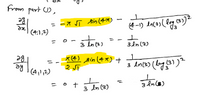Consider the function g defined by g(r, y) = cos (Tx V) + COS log3(r – y) Do as indicated. 1. Determine 2. Calculate thc instantancous rate of change of g at the point (4, 1, 2) in the direction of the vector v = (1,2). 3. In what direction does g have the maximum directional derivative at (r, y) = (4, 1)? %3D What is the mnaximum directional derivativec?
Consider the function g defined by g(r, y) = cos (Tx V) + COS log3(r – y) Do as indicated. 1. Determine 2. Calculate thc instantancous rate of change of g at the point (4, 1, 2) in the direction of the vector v = (1,2). 3. In what direction does g have the maximum directional derivative at (r, y) = (4, 1)? %3D What is the mnaximum directional derivativec?
Calculus For The Life Sciences
2nd Edition
ISBN:9780321964038
Author:GREENWELL, Raymond N., RITCHEY, Nathan P., Lial, Margaret L.
Publisher:GREENWELL, Raymond N., RITCHEY, Nathan P., Lial, Margaret L.
Chapter14: Discrete Dynamical Systems
Section14.3: Determining Stability
Problem 13E: Repeat the instruction of Exercise 11 for the function. f(x)=x3+x For part d, use i. a1=0.1 ii...
Related questions
Question

Transcribed Image Text:Consider the function g defined by
1
g(r, y) = cos (Tx T) +
log3(r – y)
Do as indicated.
1. Determine
dyðr
2. Calculate the instantancous rate of change of g at the point (4, 1,2) in the direction
of the vector v = (1, 2).
3. In what direction does g have the maximum directional derivative at (r, y) = (4, 1)?
%3D
What is the mnaximum directional derivative?
Expert Solution
This question has been solved!
Explore an expertly crafted, step-by-step solution for a thorough understanding of key concepts.
Step by step
Solved in 2 steps with 2 images

Follow-up Questions
Read through expert solutions to related follow-up questions below.
Follow-up Question
In substituting the point (4,1,2) in the partial derivatives, why does the terms without x and y becomes zero?
Solution
Follow-up Question
Why did these become zero?

Transcribed Image Text:From part U),
Be
(4.1,2)
-7 Ī sinl4x)
(4-1) Inca) ( log (33)²
3 ln(3)
3dn(3)
A(4) sin (4*) +
2 JT
3 dn13) (log(3))"
(4P12)
3 dn (8)
3 In (3)
Solution
Recommended textbooks for you

Calculus For The Life Sciences
Calculus
ISBN:
9780321964038
Author:
GREENWELL, Raymond N., RITCHEY, Nathan P., Lial, Margaret L.
Publisher:
Pearson Addison Wesley,

Calculus For The Life Sciences
Calculus
ISBN:
9780321964038
Author:
GREENWELL, Raymond N., RITCHEY, Nathan P., Lial, Margaret L.
Publisher:
Pearson Addison Wesley,